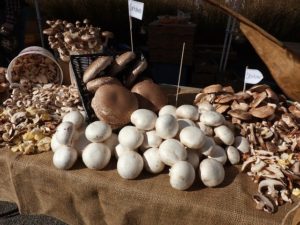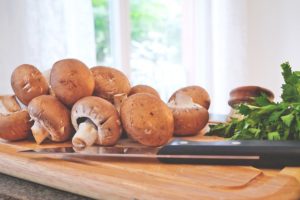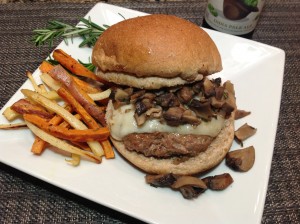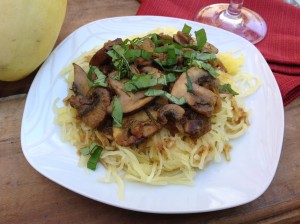 What comes to mind when you hear the word “fungi?”
What comes to mind when you hear the word “fungi?”
Does it make you want to run the other way? There was a time when we wouldn’t eat anything that contained this food, or we would at least carefully pick out any visible pieces.
But as a result of our REAL food journey, we absolutely crave them and can’t get enough!
If you haven’t guessed already, the nutritional powerhouse, which happens to be the May Superfood of the Month is….
Mushrooms!
What are they?
 If there was a food with an identity crisis, mushrooms would be it. They are not a fruit. The vegetable family won’t claim them and, technically, they are not even a plant. Unlike most fruits and vegetables, mushrooms don’t depend on sunlight for growth. They are actually the fleshy, spore-bearing body of a fungus and are typically grown above ground. This fact (and the perception that goes along with it), is what causes a lot of people to want to run the other way.
If there was a food with an identity crisis, mushrooms would be it. They are not a fruit. The vegetable family won’t claim them and, technically, they are not even a plant. Unlike most fruits and vegetables, mushrooms don’t depend on sunlight for growth. They are actually the fleshy, spore-bearing body of a fungus and are typically grown above ground. This fact (and the perception that goes along with it), is what causes a lot of people to want to run the other way.
However, if you give them a chance, mushrooms are absolutely delicious and are loaded with nutrients…they have even been used in Asian cultures for centuries as a natural cancer treatment.
 There are thousands of different varieties of mushrooms, and some of the most common are white button, cremini, shiitake, porcini, portobello, chanterelles and oyster.
There are thousands of different varieties of mushrooms, and some of the most common are white button, cremini, shiitake, porcini, portobello, chanterelles and oyster.
China is the largest producer of edible mushrooms and other significant producers include the U.S., the Netherlands, Poland, Spain and France.
In the U.S., the leading producers include Pennsylvania and California. A lot of the U.S. mushrooms and produced in Chester County, Pennsylvania.
Why mushrooms?
Mushrooms are often considered the “meat” of the vegetable world, even though they aren’t technically a vegetable. This is because of their “meaty” texture and their savory and earthy taste.
One cup of mushrooms has only 20 calories, zero fat, 3 grams of protein and 1 gram of fiber…with slight differences depending on the variety. So, they are low in calories, yet filling at the same time! Also, you may be surprised to learn that mushrooms are the only food in the produce section of the store that contain Vitamin D! Their Vitamin D content depends on their exposure to UV light and their post-harvest handling.
And, it doesn’t stop there…mushrooms are loaded with other nutritional benefits:
- Cancer fighter! Mushrooms are high in antioxidants, which we know provide enormous health benefits. They also include the mineral selenium, which is not found in most fruits and vegetables. Selenium helps liver enzyme function, helps detoxify cancer-causing compounds in the body, helps prevent inflammation and decreases tumor growth. Studies conducted by the International Journal of Cancer, as well as Researchers at the University of Perth on 2,000 Chinese women found consuming the equivalent of just one mushroom a day reduced breast cancer risk by 64%!
- Fiber keeps you full! Mushrooms contain 2 types of dietary fiber, beta-glucans and chitin, which makes you feel fuller longer (for better weight management). This fiber also benefits your digestive system and reduces the risk of heart disease.
- Heart healthy! High in potassium and low in sodium, mushrooms help lower blood pressure and decrease the risk of cardiovascular diseases.
- Better brain! Mushrooms also contain the nutrient choline, which helps with sleep, muscle movement, learning and memory.
How do you select and store mushrooms?
 You want to choose mushrooms that are firm, dry and unbruised, not slimy or withered. In some cases, it is possible the mushrooms could be grown on composted materials with pesticide residues or other unwanted substances, which can absorb into the mushrooms. If the source is questionable, you may want to opt for organic varieties if they are available.
You want to choose mushrooms that are firm, dry and unbruised, not slimy or withered. In some cases, it is possible the mushrooms could be grown on composted materials with pesticide residues or other unwanted substances, which can absorb into the mushrooms. If the source is questionable, you may want to opt for organic varieties if they are available.
It is best to store mushrooms in the refrigerator. Storing them in a paper bag, loosely closed, will help air circulate and keep them in better condition for about 4-7 days. You can also extend their freshness by not storing them in a big clump…instead, you can layer them with a paper towel in between each layer.
Because they are so porous, they can become soggy when exposed to water. For this reason, you should not wash or rinse your mushrooms until right before you are ready to use them. When you are ready to use them, you can lightly rinse them to remove any dirt or debris, and then dry them with a paper towel.
Wild mushrooms can have high levels of heavy metals and harmful chemicals, which can lead to severe illness and can even be fatal. So, make sure to receive expert advice before you go eating any wild mushrooms!
 Dried mushrooms are also a great option, especially to enjoy varieties that may not be readily available in fresh form. They should be stored in a cool dry place until you are ready to use them…storing them in the fridge or freezer will keep them good for 6-12 months.
Dried mushrooms are also a great option, especially to enjoy varieties that may not be readily available in fresh form. They should be stored in a cool dry place until you are ready to use them…storing them in the fridge or freezer will keep them good for 6-12 months.
To rehydrate dried mushrooms, place them in a bowl and add hot (or boiling) water, just enough to cover them, and let them sit in the water for 10-15 minutes. Keep in mind, you can save the soaking water and use in a recipe such as the Creamy Mushroom Risotto — it adds great flavor!
Better cooked or raw?
We are big believers in not making anything more complicated than it needs to be…especially healthy eating. You may have heard that mushrooms are toxic to eat in raw form, and you must cook them.
Is this true? It depends who you ask.
Some types of raw mushrooms contain a naturally occurring toxin called agaritine, which is deactivated by heat. Some say that you must cook mushrooms to eliminate this toxin because it is cancer-promoting. For example, it is believed that boiling mushrooms for one hour will remove 88% of the toxin (and who is really going to do that?!), and microwaving them for 45 seconds will remove 60%. And, agaritine begins to break down when mushrooms are refrigerated or dried.
Research from 2010 indicates “the risk for humans is very low, even daily consumption would not result in a measurably increased cancer risk.” And, “there is no scientifically substantiated data linking consumption of mushrooms to carcinogenicity in either animal models or humans.”
 In addition to breaking down any toxins, cooking mushrooms better releases their nutrients and makes them more digestible. This is because mushrooms’ cell walls are made of chitin, and cooking breaks down these cell walls, making them easier to digest. This can be important for those with digestive disorders. Some people also prefer the taste of cooked mushrooms vs. raw.
In addition to breaking down any toxins, cooking mushrooms better releases their nutrients and makes them more digestible. This is because mushrooms’ cell walls are made of chitin, and cooking breaks down these cell walls, making them easier to digest. This can be important for those with digestive disorders. Some people also prefer the taste of cooked mushrooms vs. raw.
So, enjoy them both ways, and not just raw all the time!
To cook them, a simple way is to sauté them with a little broth or olive oil for 5-7 minutes. Of course, there are MANY, MANY delicious ways to enjoy mushrooms…stuffed, sautéed, grilled, in pasta sauces, in eggs and frittatas, in soups and so much more!
Here are just a few ideas:
 Surprise Spaghetti Bolognese (your kids will NEVER guess there are mushrooms in this one!)
Surprise Spaghetti Bolognese (your kids will NEVER guess there are mushrooms in this one!)
Rosemary Swiss Burgers with Mushroom Sauce
Portobello Philly Cheese Steak Sandwich
Portobello Stuffed with Sausage, Spinach and Mozzarella
Pasta with Mint, Lemon and Spring Peas
Spaghetti Squash with Mushrooms and Rosemary
Mushroom Tomato Basil Bruschetta
Guinness Marinated Bison Steak Sandwiches
Take the Superfood Challenge!
Zonya and I both have adapted the habit of making a package of fresh mushrooms a shopping staple item, just like bananas and grapes…so we have them on hand all the time! Of course, our new Eat REAL Cookbook, 28-Day KickStart, includes mushrooms twice weekly throughout the 28-day menu.
Go ahead and strive for TWICE A WEEK, all month long, vastly improving your enjoyment for – mushrooms!



I love this! This proves that mushroom is another and indeed
a magical plant. Now something to spice up our dishes. My kids would love this! They will enjoy having their fave fast food snack but in a healthier version.
Amazing!
Thank you for sharing the basic thing to do on how to grow our own mushroom in our garden as well the different dishes we can do with them. All of them are a must-try! It has endless capabilities!
Thank you – you are so right, there are so many absolutely delicious ways to enjoy them! And to think, there was a day that we “thought” we didn’t like mushrooms…what were we thinking?! Thanks for the feedback!
I am looking forward to more mouth-watering recipes to try! Keep on inspiring us!
I am speechless in front of mushrooms benefits.it is very useful as well as healthy.thanks for sharing mouth watering recipes. I love these